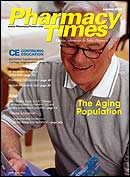Publication
Article
Pharmacy Times
HYPERTENSION WATCH
Home BP Monitoring Helps Lower Need for Drugs
A study reported in Hypertension(December 1, 2007) looked at whetherantihypertensive treatment based onself-measurement of blood pressure(BP) decreases the use of medicationwithout the loss of BP control.
For the study, 430 patients with hypertensionwere randomly assigned fortreatment using self-measured pressures(n = 216) or office pressures (n = 214). Throughout the 1-year follow-up,BP was measured by office measurement,ambulatory monitoring, and selfmeasurement.The researchers alsoassessed drug use, associated costs,and level of target organ damage. Theresearchers concluded that self-measurementresults in less medication use,compared with office BP measurement.For more information on this study, visitwww.morningbp.com/pt31
Day, Night BP Readings Both Vital
A study of 7500 participants, reportedrecently in The Lancet, questionedthat high nighttime blood pressure (BP)readings are better signs of health risk,compared with daytime BP readings.
"Some people have said that bloodpressure at night is the best predictorof risk," said Thomas Pickering, MD,who was not involved with theresearch. "This study says that is notactually the case, that the pressureover the whole 24-hour period is[best]."
Dr. Pickering chaired an AmericanHeart Association committee that in2005 recommended that physiciansand patients start doing 24-hour BPmonitoring. "We are going to make newrecommendations about home bloodpressure monitoring to say that itshould be used much more widely thanit is at the moment."
For information on this study, visitwww.morningbp.com/pt33
BP and BMI Play a Role in Heart Failure
Patients with higher blood pressure (BP) and body massindex (BMI) in mid-life face greater risk of heart failure laterin life, according to a study reported in Hypertension(November 1, 2007).
Of the 3362 participants who had routine examinationsbetween 1969 and 1994, 518 developed heart failure. Theresearchers assessed the patients' BP and pulse measureand BMI measurements. The results indicated that recentsystolic BP, pulse pressure, and BMI were all linked with thedanger of heart failure. The findings stressed the importanceof screening for elevated BP early in life. For information onthis study, visit www.morningbp.com/pt35
Preeclampsia Associated with Heart Disease
Norwegian researchers found that women with cardiovascularrisk markers have greater risk of developing preeclampsia,according to a study reported in the November 10, 2007, issueof the British Medical Journal.
The study of 3494 women found that those women who hadhigh blood pressure (BP), high cholesterol, and high blood glucoselevels before pregnancy increased the risk of preeclampsia7-fold. The findings also showed that women with a familyhistory of high BP, heart disease, or diabetes had twice the riskof developing preeclampsia.
?The findings suggest that preeclampsia and cardiovasculardiseases may share a common origin, and that the increasedrisk of cardiovascular disease subsequent to preeclampsia, atleast partly, is due to an underlying biological trait of thewoman,? said research fellow Elisabeth Balstad Magnussen.
The findings emphasize the need for women with a history ofhigh BP to monitor their BP at home during pregnancy. Forinformation on this study, visit www.morningbp.com/pt32
Not All Home BP Monitors Meet Validation Protocols
Blood pressure (BP) monitors that fail validation protocolscan lead to BP errors that expose patients to preventablerisks of heart disease, renal failure, and mentaldecline, emphasized Clarence Grim, BS, MS, MD, andCarlene M. Grim, BSN, MSN, SpDN, NP, during a posterpresentation at the recent American College of NursePractitioners Clinical Conference.
To avoid home BP devices that have failed validationprotocols from being sold in the United States, they recommendthat all home devices be required to have passedone of the standard validation protocols, such as the oneestablished by the European Society of Hypertension orthe Association for the Advancement of MedicalInstrumentation. In addition, any device used by a patientor the physician?s office must be validated as accurate ineach individual patient. This process should be done every6 months. For information on this presentation, visitwww.morningbp.com/pt34
F A S T F A C T : Preeclampsia is the leading cause of maternal and fetal death.







